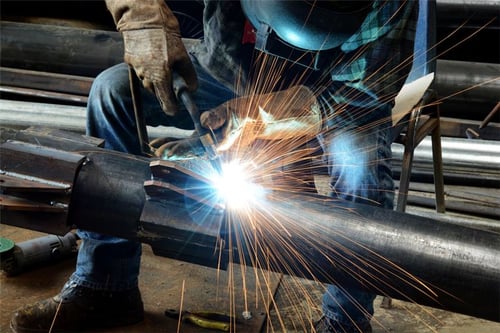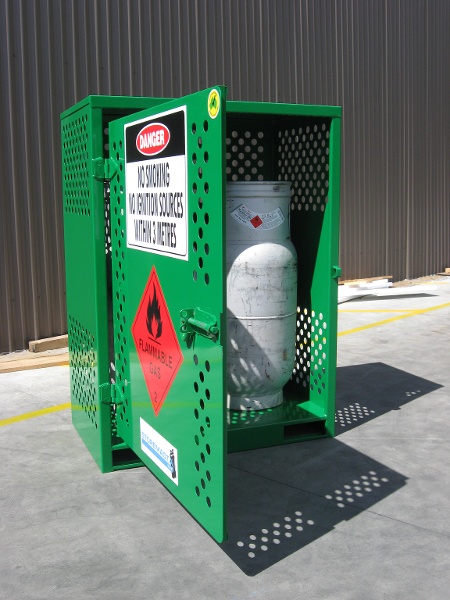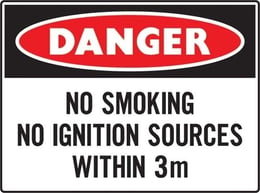Gas bottles and cylinders are pressure vessels that are used to store gases at extremely high pressures. While this poses a physical risk, it’s important to understand that the gases stored within these cylinders are often dangerous. This post will look at the gas bottle storage requirements and how you can reduce the hazards associated with gas cylinders through compliant storage practices.
What Tyes of Gas are Stored in Cylinders?
The main types of dangerous gases that are stored within gas cylinders include:
- Class 2.1 - Flammable Gas
- Class 2.3 - Toxic Gas
Other classes of dangerous goods that are often stored within gas cylinders include class 2.2 - non-flammable, non-toxic gas.
Hazards of Gas Cylinders
There are two main types of hazards that surround compressed gases stored in cylinders. The health and physiochemical hazards of the chemical — as well as the physical hazards of the cylinders that contain gases which are compressed and pressurised.

Many workplace accidents have occurred when gas bottles, such as those required for welding applications, aren’t stored or handled correctly.
Health and Physiochemical Hazards
Unfortunately, countless workers have been injured or killed due to exposure to certain types of gases. Gases such as chlorine or ammonia can have toxic or corrosive properties which can result in fatalities or serious health problems.
When exposure to these gases occurs, workers may experience acute reactions, including burns, rashes or blindness. They may suffer from chronic health conditions such as asthma or cancer.
Inert gases (argon, helium, neon and nitrogen) are sometimes considered relatively harmless but can asphyxiate workers by displacing oxygen from the air. Many of these gases are colourless and odourless so workers can enter oxygen deficient areas without realising there is a hazard present.
Workers can be burned or die when flammable gases (LPG, methane and acetylene) cause fires and explosions. These gas cylinder fires can be exacerbated by oxidisers (pure oxygen) causing the fires to burn hotter making them harder to extinguish.
Physical Hazards
Gas bottles and cylinders pose an extreme risk to people and property even when the gases within the gas cylinder are non-hazardous. This risk is due to the extreme pressure of the gas within the cylinder. If a gas cylinder tipped over and the valve block sheared off, the contents within the gas cylinder would rapidly disperse. The rapid dispersion of these gases would cause the gas cylinder to become a flying projectile, potentially causing property damage, injury or death.
Gas Regulations and Requirements in Australia
The handling and storage of gas cylinders is regulated in Australia. Each State and Territory of have their own laws to regulate the storage and handling of gases in cylinders.
If your organisation operates across a number of States and Territories, it can be hard to comply with the different regulations that apply to each State and Territory.
However, this confusion can be overcome by following the requirements outlined in the Australian Standards.
The Australian Standards are national standards that are accepted as an important part of meeting regulatory compliance. The Australian Standard that outlines the requirements for the storage and handling of gases in cylinders is AS 4332. An overview of the storage and handling requirements according to this standard are outlined below.
Gas Cylinder Store Construction Requirements
For the storage of gas bottles and cylinders to be compliant, they must be kept in a gas cylinder cage that meets the construction requirements of AS 4332.
These requirements are outlined below:
- Gas cylinder stores must be constructed from non-combustible material
- The base of the gas cylinder store must be level. If drainage is required the floor must be sloped in a way that doesn’t compromise cylinder stability.
- Any space between the base of the gas cylinder store and the ground must be filled with a solid non-combustible material - or have at least 2 ends completely open to the air.
- Any gas cylinder store that is attached to or located within a building must be separated from the rest of the building by one or more walls. Each of the walls must have a fire-resistance level (FRL) of 240/240/240.
- The floor above any gas cylinder store in a multi-storey building must be constructed of a material having a fire-resistance rating of 180/180/180.
- The walls and roof of gas cylinder stores must be of a non-combustible material. Where practical the supporting structure must also be of non-combustible material.
- Bollards and crash barriers must be installed where there is a risk of cylinders being damaged by vehicles in the surrounding area.
- Ignition sources must be excluded from any gas cylinder store containing flammable gases.
- The doors of gas cylinder stores must open outwards or be a ventilated roller door that can be opened from inside the store.
- Any electrical equipment installed in gas cylinder stores must comply with AS/NZS 3000 and all electrical fittings must be installed in a way that prevents them from being damaged by impact from cylinders.
- Gas cylinder stores must also have gas cylinder restraint bars and chains to prevent the gas bottles from falling over.
IMPORTANT: We highly recommend storing gases in compliant cages that are kept outside. Cages will be equipped with ample natural ventilation to allow for the dispersal of harmful gases, as well as a lockable door to prevent unauthorised entry to the cylinder cage.
Gas Cylinder Store Lighting Requirements
In areas where gas bottle cages are located there must be sufficient lighting to enable personnel to read the markings on gas cylinders, signs and gas cylinder instruments such as regulators. Also, to allow for safe escape in the event of an emergency, all internal roads that lead to areas, rooms or stores where gas cylinders are kept must be sufficiently illuminated.
Ventilation Requirements for Gas Cages
To ensure that any gases that may leak from gas cylinders don’t build up inside the store, all gas cylinder stores must be sufficiently ventilated. A ventilation system must be capable of:
- Diluting any vapours or gases within the store to levels below the workplace exposure limits.
- Providing sufficient fresh air from outside to reduce the risk of asphyxiation.
- Sufficiently ventilating the atmosphere within the store at high and low levels relative to the floor.
These ventilation requirements can be achieved with either a natural or mechanical ventilation system. A mechanical ventilation system for flammable gas cylinder stores must be intrinsically safe to prevent the risk of fires. Intrinsically safe ventilation systems can be impractical in the outdoor environments and therefore natural ventilation systems are often the preferred option.

Natural ventilation in gas bottle stores is a cost-effective option to ensure a safe and healthy working environment.
A natural ventilation system can be achieved by having two opposing walls open to the outside atmosphere. These walls can be covered with a wall of wire mesh or louvers.
Dangerous Goods Segregation for Gases
All gas cylinder stores must be isolated from industrial heat, combustibles, vegetation, refuse, ignition sources, building entrances and openings, as well as other dangerous goods.
Additionally, incompatible gases must be segregated within the store. The Standard specifically identifies the following gases to be kept at least 3 metres apart:
- Class 2.1 - Flammable gases (acetylene, LPG)
- Class 2.2 (5.1) - Non-flammable, oxidizing gases (oxygen)
- Class 2.3 - Toxic gases (chlorine)
If it’s not possible to physically segregate these gases, a segregation wall should be erected. The wall must be constructed from non-combustible materials and stand at least 1 metre higher than the tallest cylinder. It must also be impervious to any gas vapours.
Dangerous Goods Signage
To ensure that everyone in the workplace is aware of the specific risks associated with dangerous gases stored in the workplace, it’s crucial to have the correct dangerous goods signage on all gas cylinder stores. There are three different classes of dangerous gases and each class requires different signage.
All gas cylinder stores must also have a sign that states “No Smoking No Ignition Sources Within 3m”. An example of this sign is shown below:
No Smoking No Ignition Sources Within 3m

Gas Cylinder Safety in the Workplace
As there are many risks associated with the storage and handling of gases in cylinders, it’s really important to store gas cylinders in the right way. By following the requirements of the Australian Standard AS 4332, you can manage the risks associated with your gas cylinders. Like to find out more about the safe storage of flammable gases and other flammable material? Simply download our FREE eBook today for practical advice on reducing risk with your flammable gases and liquids.
Joining the team as a Dangerous Goods Storage Consultant, Melissa Hampton became Storemasta's Marketing Manager in late 2021. With extensive knowledge and experience in chemical compliance, Melissa is responsible for leading the Marketing team and helping shape their marketing strategy. In her spare time, you can find Melissa hiking, swimming and enjoying the great outdoors in beautiful north-west Tasmania.
